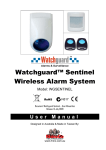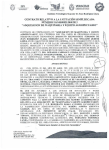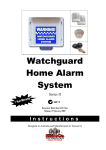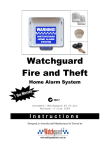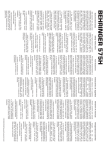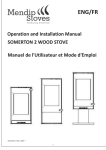Download Watchguard WGSENTINEL User manual
Transcript
Watchguard™ Sentinel Wireless Alarm System Model: WGLCA Document: Watchguard Sentinel – User Manual.doc Release: 23 January 2009 User Manual Designed in Australia & Made in Taiwan By: www.rhino.com.au 2 Contents Contents ......................................................................................................... 2 1. Introduction ................................................................................................. 3 1.1. What You Get ....................................................................................... 4 1.2. The Passive Infrared Detector (PIR) ..................................................... 5 2. Installation................................................................................................... 6 2.1. Planning the Installation........................................................................ 6 2.2. The Main Unit ....................................................................................... 7 2.3. The Power Supply ................................................................................ 8 2.4. The Detectors ....................................................................................... 9 2.4.1. Tips for positioning ......................................................................... 9 2.4.2. Powering the detector .................................................................. 11 2.4.3. Warm up period............................................................................ 11 3. Operation .................................................................................................. 12 3.0. Turning the system on ........................................................................ 12 3.1. Remote Control Functions .................................................................. 12 3.2. ARM Mode.......................................................................................... 12 3.3. DISARMING ....................................................................................... 13 3.4. PANIC Mode....................................................................................... 13 3.8. The Passive Infrared Detectors .......................................................... 13 3.8.4. Dual Edge Sensing (DES) technology ‘explained’ ........................ 13 4. Programming ............................................................................................ 16 4.1. Adding New Remotes ......................................................................... 16 4.2. Adding a Detector ............................................................................... 17 5. Maintenance ............................................................................................. 18 5.1. The Remote Control ........................................................................... 18 5.2. The Detector....................................................................................... 18 5.2.1. Replacing the batteries................................................................. 18 5.2.2. Cleaning the pyro detector ........................................................... 19 5.2.3. Cleaning the case and lense ........................................................ 19 6. Warranty ................................................................................................... 20 6.1. Warning Limitations & Warranty.......................................................... 20 3 1. Introduction Your Watchguard Sentinel Home Alarm System is specifically designed for simple DIY installation (Do It Yourself). It is suitable for use in homes or offices where the owner wishes a siren to trigger if there is unauthorized entry into the premises. Main Features include: • Simple installation • Hand held remote controls • Remote functions include arm, disarm, and panic. • Ability to add or erase detectors from your system. • Up to 5 wireless devices can be used (any combination of remotes or sensors) • Protects your family and property • Suitable for home and office • Powerful external siren with flashing blue warning light • Main power adaptor with a 10m lead • Latest technology • Wireless detectors available include Passive Infrared detectors, Reed Switches and Smoke Sensors. 4 1.1. What You Get Below is a list of parts included with system. Item Description 1. Main control unit The unit incorporates a powerful siren and a flashing blue light. The system has mains connection via a low voltage plug pack that is supplied with the unit. 10m of connection cable is provided. 2. 1 Passive Infrared Detector Designed to detect the body movement of an intruder inside your premises. These intelligent devices allow simple installation, as no cable is required between the main unit and the detectors. The long life lithium batteries will last for up to 3 years. 5. 2 Power Supply (plug pack) The main unit requires a regular mains power supply. The Watchguard is supplied with a 12V DC plug pack that connects to the main units power connector on the end of the 10m cable. 4. 1 Remote controls 2 x Remote Controls. These allow you to easily arm & disarm the system from anywhere in your home. In case of duress, you can also trigger the alarm at any time from the remote control. 3. Quantity 1 Mounting Material & Screws Necessary wall mounting screws & wall plugs are included. 1 Image 5 1.2. The Passive Infrared Detector (PIR) The detector is a high quality infrared body movement detector, which is battery operated and communicates with the Watchguard Sentinel Home Alarm System via radio frequency (RF) transmission. This detector is easy to install, provides excellent detection sensitivity and has a long battery life (up to 3 years). This detector transmits an alarm code to the unit when a valid movement is detected. IMPORTANT NOTES • NEVER touch the pyro detector with your fingers • During the warm up period, (first 3 minutes after installing the batteries) the detector will not respond to movement in front of the detector. You must wait 3 minutes before it will respond properly. The wire, which runs around the edge of the detector, is the antenna. Do not touch, remove or cut this wire 6 2. Installation 2.1. Planning the Installation Each separate component of the Watchguard Sentinel Home Alarm System should be placed in strategic locations. Below is a guide to where you should place the main unit and the detectors. It is important that you take into account that the maximum range without any obstructions between the main unit and each detector is no further than 50 metres. Typically the range inside your house will be around 20-50 metres depending on the construction of the house. Planning and Wire Routing Figure 1 1- The Watchguard Sentinel main unit should be located high on the front or front side of the building under an eave of covering. (See Section 2.2) 2- Route the white-white/black wire (2 core-figure 8 cable) from the main unit through the ceiling to connect with the plug pack connector. Another suitable location for the power supply is on an available power point at the rear of the fridge in the kitchen. (See Section 2.3) P1- Location of passive infrared detector zone 1. (Example only) 7 2.2. The Main Unit Mount the Watchguard main unit at the front or front side of the building. The mounting position should be under an eave or out of direct contact with rain or other water sources. The position should allow line of sight viewing from both the street (for visual deterrent) and from your main point of entry (for visual confirmation of arming/disarming). Use the wall plugs and screws provided if suitable for your particular building construction. Installing the main unit Figure 2 Figure 3 1. Drill mounting holes (7mm diameter, 25mm minimum in depth) into the chosen wall. 2. Use the green star plug. Press each one into the 3 main mounting holes. 3. Make a hole and push the wires through the wall and up into the ceiling. 4. Screw the top 2 screws half way in. 5. Place the unit to support itself from the top 2 screws. 6. Screw in and tighten the bottom mounting screw then tighten the top two screws. 8 2.3. The Power Supply Inside Roof Power Supply Mounting 1. Drill a small hole (15mm diameter) into the ceiling where the wire can go through to be connected to the wire from the main unit. 2. Feed the wire through the hole in the ceiling and up to where it will join the wire from the main unit. 3. Connect the connector from the power supply into the plug from the main unit as shown below. Wall Figure 4 9 2.4. The Detector Firstly, the mounting bracket must be fixed to the wall using the self-tapping screw and other accessories supplied. Mounting must be at a minimum height of 1.2 metres and maximum of 2.1 metres (lower is better). Drill a 5mm diameter hole (at least 30mm deep) into the gyprock for mounting the detector bracket/socket base. Push the wall plug into the hole then screw in the mounting bracket. It will clip into the base. The detector can now be slid onto the swivel bracket. See diagram below. Approx mounting angle at 2.1m Figure 5 2.4.1. Tips for positioning • This detector utilises the very latest in detection processing technology to reduce the possibility of false alarms. However, correct mounting of the detector is critical to ensure best detection or "catch" performance. You cannot just screw the detector directly to a wall up high in a corner and expect best performance. Thoroughly test each detector, and if detection is not acceptable in the location you have chosen, adjust the angle of the detector slightly & re-test. You will find that a slight up/down angle change may improve catch performance significantly. 10 • Mount the detector on your wall using the swivel mount provided at a minimum height of 1.2 metres and maximum of 2.1 metres (lower is better). Make sure the detector is a minimum of 5 metres away from your main unit so it doesn’t swamp the receiver with a signal that is too strong to decode. • Always mount your detector so that an intruder has to walk across its zone, i.e. walk past the detector, not towards it. • DON’T mount detector facing glass doors or windows. Always mount above windows and doors to look inside. • DON’T mount detector facing hot areas or areas where the temperature may change suddenly, e.g. open fire places, direct sunlight or air conditioning vents. • Select a location where the detector can provide the best detecting range. Always ensure that you do not cover an area with multiple detectors, so as to avoid simultaneous transmission back to the receiver in your Watchguard Sentinel Home Alarm System. The receiver can only decode one coded signal at any given time. • If the detector is mounted close to metal frames or doors, this may reduce the radio transmitting range. • The detector is not waterproof and is designed for indoor use only. 11 2.4.2. Powering the detector When you first remove the detector from the box it is not powered, although the batteries are in place. To turn the detector on, pull the piece of plastic from one of the battery terminals (in the direction indicated in figure 7). If the light does not flash, the plastic has not been removed properly. You may need to clear any excess plastic from the battery terminal. If all plastic have been cleared and the detector is still not responding then remove the batteries, which the plastic was covering and slide the batteries back into their original position. If after this you still don’t have any response from the detector then the batteries may be flat. I M P O R T A N T 2.4.3. Warm up period Figure 6 Unclip the front cover as shown You must wait approximately 3 minutes for the detector to warm up after connecting the batteries. This time starts from when the detector starts flashing the red light after removing the piece of plastic from under one of the battery terminals. During this period the detector will not respond and should be left untouched until the 3 minute period is up. Figure 7 12 3. Operation 3.0. Turning the system on The system is automatically turned on when the power plug is connected and switched on. On power up the system is in the armed state, which means that the alarm can be triggered by the detectors. This function is to make sure that if the power is disconnected i.e. via a blackout or switched on/off that the system is not disarmed when power is restored. 3.1. Remote Control Functions Press ARM/DISARM Pressing the button will arm or disarm the alarm system depending on the current state of the alarm. That means if the alarm is armed then pressing the button would disarm it, similarly if the alarm is disarmed then pressing the button would arm it. PANIC mode Press and hold (approximately 3 seconds) to activate PANIC mode. 3.2. ARM Mode When to use This mode is used when leaving the building or premise. Arming the system in this mode will activate all detectors. Indications The siren will beep once and the blue light will flash once. There will be a 20 second delay before the system is fully armed. During this delay detectors cannot trigger the alarm. Triggering If a detector is triggered, when the system is fully armed, the alarm will sound for 5 minutes or until the system is disarmed (which ever occurs first). 13 3.3. DISARMING When to use The system should be disarmed before entering the building or premise. Indications The siren will beep twice and the blue light will flash twice. The siren will beep 12 times instead of twice, if the alarm has been triggered while the system was armed. 3.4. PANIC Mode When to use This mode should be used when the user wishes to activate the siren possibly used in an emergency situation. What happens The siren will sound and the blue light will flash to alert people in the area. 3.8. The Passive Infrared Detector It is vital that the detector is tested carefully for each installation. At 25°Celsius, the detector should have a detection range of approximately 10 metres and a scope angle of 90°, i.e. 45° either side of the centre position straight ahead of the lens. 3.8.4. Dual Edge Sensing (DES) technology ‘explained’ Figure 8 – side view, detection pattern in optimal temperature environment 14 This detector has Dual Edge Sensing (DES) Technology, developed to eliminate false alarms yet still provide maximum security. The detector uses a pattern of infrared beam zones to sense body movement. The detection pattern in an optimal temperature environment is shown in figure 9. Each time you walk into or out of an infrared beam zone this will be sensed and processed by the DES technology built into the detector. The red trigger light will not turn on until the detector has made a valid movement detection in normal mode. Figure 9 – detection pattern in the optimal temperature environment 15 Triggering the detector Figure 10 – most sensitive trigger In figure 10, a body moving from position 1 to position 2, into the infrared beam zone, will create a pulse. Moving from position 2 to 3, out of the other side of the same infrared beam zone, will create another pulse. If the body moves from position 1 to position 3 within 10 seconds then the detector will have received 2 pulses in 10 seconds. This means the detector will have made a valid movement detection and will trigger, indicated by the red light. This also applies if the body moves in the opposite direction. No trigger body movements No trigger body movements are body movements which are too small to be recognized as valid body movements to trigger the detector. Figure 11 – no trigger In the example, shown by figure 11, a body walking into one side of the infrared beam zone, then back out the same side of the infrared beam zone will not trigger the detector. A body moving from position 1 to 2, into the infrared beam zone, will only create pulsing. A body moving from position 2 back to position 1 or from position 2 to position 3 (out of the same side of the infrared beam zone) may create further pulses but will not trigger the detector. This also applies if the body is moving in and out of the infrared beam zone from the other side. 16 4. Programming Turning the unit off and on enters programming mode. On each instance of programming mode only a single device may be learnt in. To learn in another device programming mode must be re-entered by turning the device off then on again. 4.1. Adding New Remotes + TO ADD A NEW REMOTE 1. Turn the system off, by turning off the power supply. Wait 10 seconds. 2. Turn the system on. 3. Press the remote button several times until the siren starts beeping. Your Watchguard Sentinel Home alarm System can only store a maximum of FIVE wireless devices in its memory. If you learn in an 6th remote, the 1st remote control will be erased. If you loose a remote control, or have one stolen, or wish to delete a detector simply repeat the procedure above with one of your remote controls at least 5 times. This will ensure that you have erased all wireless devices (except the remote control being used in the procedure) from the memory of your Watchguard Sentinel Home Alarm System. 17 4.2. Adding a Detector + TO ADD A DETECTOR 1. Turn the system off, from the power supply or unplug. Wait 10 seconds. 2. Turn the system on. 3. Wave your hand back and forth in front of the detector until the red light turns on. The siren will start screaming. 18 5. Maintenance The complete system should be tested at regular intervals. We suggest testing it once every fortnight or at least once per month. 5.1. The Remote Control The batteries in the remote control will need to be replaced every 1 to 3 years, depending on usage. You are able to recognise when the batteries are low from when the range on the remote control reduces. Below describes how to replace the batteries in the remote control. Battery Specifications Battery Type Model Voltage 2 x Lithium button cells CR1616 3 Volts 5.2. The Detector 5.2.1. Replacing the batteries The batteries can be removed by un-clipping them out of the plastic battery holders. The new batteries must be handled only by the edges as the chemicals in your skin may cause a poor battery connection. Fingerprints can be cleaned off the batteries with a soft cloth and some alcohol solution. The new batteries can now be slid into the battery holders making sure that the top terminal is pressing down firmly on top of each battery. Just after each battery is replaced the lights will begin flashing 6 times to confirm the detector is now powered. The 3 minute warm up period now applies. Detector Battery Specifications Battery Type Model Voltage 2 x Lithium button cells CR2450 3 Volts 19 When replacing the batteries you must take the following into consideration: • You must replace both batteries at the same time. Don’t just replace one of them. • Be sure not to touch the pyro detector on the removal or replacement of the batteries. 5.2.2. Cleaning the pyro detector The pyro detector must be clean at all times for optimum performance. If the pyro detector appears to have any dust, dirt or fingerprints on it, then it should be cleaned. To clean the pyro, use a soft cotton cloth (not a tissue), which has been dampened with Metholated Spirits (Alcohol). Gently wipe across the window of the pyro detector with the dampened cloth. Be sure not to touch the pyro detector with you fingers. 5.2.3. Cleaning the case and lense Detectors are often left in position for long periods and spiders or other pests might stay around the detector. It is important that the lens, especially, is kept clean of any spider webs or pests from being in front of it. It is recommended to keep the whole case clean by wiping over it with a soft cloth to remove dust, pests or other obstructions as required. This will also reduce the risk of a false alarm due to pests. Do not spray on or near the lens with insect/repellent spray. Remember not to move the position or angle of the detector as it may affect the performance of the detector. If in doubt, carry out a walk test to ensure the detector is operating correctly. 20 6. Warranty 6.1. Warning Limitations & Warranty While this system is an advanced design security system, it does not offer guaranteed protection against burglary, fire or any other emergency. Any alarm system, whether commercial or residential, is subject to compromise or failure to warn for a variety of reasons. For example: • Intruders may gain access through unprotected openings, or have the technical sophistication to bypass an alarm detector or disconnect an alarm warning device. • Intrusion detectors (e.g., passive infrared detectors), smoke detectors, and many other sensing devices will not work without power. Battery operated devices will not work without batteries, with dead batteries or if the batteries are not put in properly. Devices powered solely by AC will not work if their AC power supply is cut off for any reason, however briefly. • Signals sent by wireless transmitters may be blocked or reflected by metal before they reach the alarm receiver. Even if the signal path has been recently checked during a weekly test, blockage can occur if a metal object is moved into the path. A user may not be able to reach a panic or emergency button quickly enough. • While smoke detectors have played a key role in reducing residential fire deaths, they may not activate or provide early warning in as many as 35% of all fires, for a variety of reasons, according to data published by the US Federal Emergency Management Agency (Figures from USA Statistics only). Some of the reasons smoke detectors used in conjunction with this system may not work are as follows: Smoke detectors may have been improperly installed and positioned. Smoke detectors may not sense fires that start where smoke cannot reach the detectors, such as in chimneys, in walls, or roofs, or on the other side of closed doors. Smoke detectors may not sense a fire on another level of a residence or building. A second floor detector, for example, may not sense a first floor or garage fire. Moreover, smoke detectors have sensing limitations. No smoke detector can sense every kind of fire. In general, detectors may not always warn about fires caused by carelessness and safety hazards like smoking in bed, violent explosions, escaping gas, improper storage of flammable materials, overloaded electrical circuits, children playing with matches, or arson. Depending on the nature of the fire and/or the location of the smoke detectors, the detector, even if it operates as anticipated, may not provide sufficient warning to allow all occupants to escape in time to prevent injury or death. • Passive Infrared Motion Detectors can only detect intrusion within the designed ranges as diagrammed in their installation manual. Passive Infrared Detectors do not provide volumetric area protection. They do create multiple beams of protection, and intrusion can only be detected in unobstructed areas covered by the beams. They cannot detect motion or intrusion that takes place behind walls, ceilings, floors, closed doors, glass partitions, glass doors, or window. Mechanical tampering, masking, painting, or spraying of any material on the mirrors, windows or any part of the optical system can reduce their detection ability. Passive Infrared Detectors sense changes in temperature; however, as the ambient temperature of the protected area approaches the temperature range of 32°c to 65°c, the detection performance can decrease. 21 • Alarm warning devices such as sirens, bells or horns may not alert people or wake up sleepers who are located on the other side of closed or partly open doors. If warning devices sound on a different level of the residence from the bedrooms, then they are less likely to waken or alert people inside the bedrooms. Even persons who are awake may not hear the warning if the alarm is muffled by noise from a stereo, radio, air conditioner or other appliances, or by passing traffic. Finally, alarm warning devices, however loud, may not warn hearing-impaired people or waken deep sleepers. • Telephone lines needed to transmit alarm signals from a premise to a central monitoring station may be out of service or temporarily out of service. Telephone lines are also subject to compromise by sophisticated intruders. • Even if the system responds to the emergency as intended, however, occupants may have insufficient time to protect themselves from the emergency situation. In the case of a monitored alarm system, authorities may not respond appropriately. • This equipment, like other electrical devices, is subject to component failure. Even though this equipment is designed to last as long as 10 years, the electronic components could fail at any time. • The most common cause of an alarm system not functioning when an intrusion or fire occurs is inadequate maintenance. This alarm system should be tested weekly to make sure all detectors are working properly. • Installing an alarm system may make one eligible for lower insurance rates, but an alarm system is not a substitute for insurance. Homeowners, property owners and renters should continue to act prudently in protecting themselves and continue to insure their lives and property. We continue to develop new and improved protection devices. Users of alarm systems owe it to themselves and their loved ones to learn about these developments. LIMITED WARRANTY RhinoCo Technology (Seller), warrants its products to be in conformance with its own plans and specifications and to be free from defects in materials and workmanship under normal use and service for twelve months from the date of original purchase. Sellers obligation shall be limited to repairing or replacing, at its option, free of charge for materials or labor, any part which is proved not in compliance with Sellers specifications or proves defective in materials or workmanship under normal use and service. Seller shall have no obligation under this Limited Warranty or otherwise if the product is altered or improperly repaired or serviced by anyone other than Seller. For warranty service, return transportation prepaid, to your local RhinoCo branch. Seller has no obligation to attend the buyer’s location to retrieve the goods or make repairs onsite. There are no warranties, expressed or implied, of merchant ability, or fitness for a particular purpose or otherwise, which extend beyond the description on the face hereof. In no case shall seller be liable to anyone for any consequential or incidental damages for breach of this or any other warranty, express or implied, or upon any other basis of liability whatsoever, even the loss or damage is caused by its own negligence or fault. Seller does not represent that the products it sells may not be compromised or circumvented; that the products will prevent any personal injury or property loss by burglary, robbery, fire or otherwise; or that the products will in all cases provide adequate warning or protection. Customer understands that a properly installed and maintained alarm system may only reduce the risk of a burglary, robbery, or fire without warning, but it is not insurance or a guarantee that such will not occur or that there will be no personal injury or property loss as a result. Consequently, seller shall have no liability for any personal injury; property damage or other loss based on a claim the product failed to give any warning. However, if seller is held liable, whether directly or indirectly, for any loss or damage arising under this limited warranty or otherwise, regard 22 less of cause or origin, seller's maximum liability shall not in any case exceed the purchase price of the product, which shall be the complete and exclusive remedy against seller. This warranty replaces any previous warranties and is the only warranty made by Seller on this product. No increase or alteration, written or verbal, of the obligations of this Limited Warranty is authorised. NOTE: In addition to the warranty conditions, warranty will not be given where a product has been immersed in water under any circumstances, or where damage has been caused by hosing the main unit, without all due care taken by the owner to protect the main unit by covering with some sort of plastic sheeting. 23 PLEASE CUT OUT & RETURN THIS INFORMATION WITHIN 14 DAYS OF PURCHASE TO YOUR LOCAL OFFICE: RhinoCo Technology Head Office: 9 Hannabus Place, McGrath’s Hill, NSW, 2756 Australia UK Sales Office Italy Sales Office South Africa Sales Office Unit 6 Ubique Park, March Way, Battlefield Enterprise Park, Shrewsbury, SY1 3JE United Kingdom 24 Piazza Garibaldi, 98034 Francavilla Di Sicilia (ME) Italy Route 21 Corp/Park, Unit C3 Prospect Close, 311 Regency Drive, Irene Ext 30, South Africa Wa tc hguar d Se nti nel Hom e Al a r m S ys t e m Wa rra nt y Ca rd Name Address Suburb Email Date of Purchase Daytime Phone Where did you purchase your Watchguard System? Store Location State Postcode Invoice Number Who installed your Watchguard System? This information will only be used by the manufacturer and will not be sold to any third parties. Dear Customer, We appreciate your confidence in our product, and you can be certain that we will do everything possible to ensure that you are happy with your decision and that you have years of satisfaction from your Watchguard System. We take extreme care in the research, design and development of our products to ensure they meet your needs. Additionally, we keep in close contact with our dealers worldwide, and should any problem occur, we will work closely with your local dealer to see that it is resolved quickly. As a leading designer and manufacturer, we are continually endeavouring to exceed the expectations of our customers. Furthermore, we appreciate your input regarding potential design improvements, issues regarding our service and support, and any other ideas you may have which could help us to serve you better. Please make any comments you have here:























